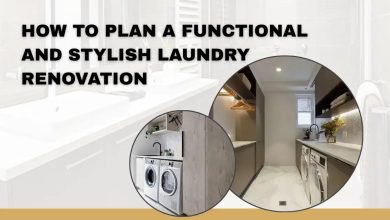How to Renovate Your Apartment Kitchen on a Budget in Sydney

Renovating a kitchen in an apartment can feel like a luxury and an expensive one at that. But in Sydney, where space is often compact and design trends lean toward clean, functional layouts, you can get a big visual and functional lift without draining your savings. This guide walks you through a practical, budget-first approach: planning, where to spend and where to save, DIY vs trades, and finishing touches that make the space feel high-end even when you’ve kept costs low.
1. Start with a plan (this saves money more than you think)
Before you pick tiles or binge kitchen Instagram, write a short plan:
- What must the new kitchen do? (More storage? A proper oven? Bigger fridge?)
- What’s nice to have?
- Your non-negotiables (e.g., keep existing plumbing positions, keep rental bond-friendly finishes).
- Set a firm budget and include a 10–15% contingency for surprises.
If your space is small, your plan should prioritise functionality. In many cases, an kitchen renovation focuses on making the most of every corner without costly structural changes.
2. Know the constraints of apartment living
In an apartment you’ll often face:
- Fixed plumbing and electrical positions (moving them is expensive).
- Body corporate or strata rules (some works need approval).
- Limited space for large trades or deliveries.
Before you start any structural changes, check your strata rules and building manager requirements. For anything involving gas, major plumbing, or electrical rewiring, you’ll need licensed tradespeople don’t cut corners here.
3. Decide what to DIY and what to hire
Smart splitting of work saves a lot:
Good DIY tasks:
- Painting walls and cabinets (if they’re in solid condition).
- Installing open shelves.
- Swapping cabinet handles and light fittings.
- Tiling a small splashback (if you have patience).
- Laying peel-and-stick flooring in small areas.
Hire a pro for:
- Gas appliance installation.
- Major plumbing work (moving sinks, installing dishwashers).
- Electrical changes and adding circuits.
- Structural changes or removing load-bearing elements.
Tip: If you’re already planning broader upgrades, it might be worth aligning the work with other Home renovations Sydney projects to save on trades’ call-out costs and coordinate deliveries.
4. Where to spend and where to save
Spend smartly on what affects daily use and looks:
Spend on:
- Worktops: This is used constantly and makes a huge visual impact. Laminate can be cheap and durable; if you can stretch, consider engineered stone for longevity.
- Sink & tap: A good tap lasts, works better, and looks more premium.
- Lighting: Under-cabinet lights and a quality overhead light improve usability and atmosphere.
Save on:
- Cabinet carcasses: If structure is okay, refacing or repainting doors is much cheaper than replacing cabinets.
- Appliances: Buy last year’s model or energy-efficient secondhand (trusted sellers). If you’re renting, keep appliances that match the bond rules.
- Flooring: Use vinyl plank or high-quality laminate rather than timber looks similar at a fraction of the cost.
- Backsplash: Use subway tiles, painted plywood (sealed), or peel-and-stick tiles for a modern look without a tiler’s bill.
A simple rule of thumb: spend where you touch/see most (worktops, sink, lighting) and save on hidden or easily changeable elements.
5. Cabinet refresh vs full replacement
Cabinet refresh options (cheaper):
- Paint or lacquer: A fresh coat + new hardware can transform cabinets.
- Refacing: Replace doors and drawer fronts, keep carcasses cheaper than full replacement.
- Open shelving: Remove some doors and install shelves for a modern look. Works best in bright, tidy kitchens.
When to replace:
- Cabinets are water-damaged, warped, or poorly built.
- Layout needs to change to improve workflow (but remember moving plumbing is costly).
6. Appliance strategy
- Prioritise energy-efficient appliances upfront cost can be offset by lower bills.
- Consider built-in vs freestanding: freestanding appliances are cheaper and easier to replace.
- Look for package deals from big retailers or sales around major shopping seasons.
- If you’re in a rental, check what upgrades are allowed. Some landlords will contribute if the upgrade increases property value.
7. Affordable materials & finishes with style
Budget-friendly materials that still look great:
- Laminate benchtops modern designs mimic stone.
- Subway tiles for splashbacks classic, inexpensive, easy to DIY.
- Peel-and-stick tiles good for renters or quick installs.
- Vinyl plank flooring water-resistant and low-cost.
- Open shelving in timber or metal creates airiness and cost-savings.
Colour and texture make a cheap material feel premium. Matte black hardware, warm timber accents, and clean grout lines can elevate inexpensive surfaces.
8. Hacks to save on labour
- Time tradespeople: schedule multiple small jobs together (e.g., electrician + installer) to reduce call-out fees.
- Do demolition yourself if strata allows and it’s safe removing old tiles or offloading old cabinetry can cut labour time.
- Reuse materials where possible a resurfaced cabinet or repurposed timber shelf reduces waste and cost.
9. Keep it rental/strata-friendly (if applicable)
If you rent or plan to resell, focus on neutral, durable finishes. Avoid permanent, personalised choices (like bold bright tiles) unless you plan to move them later. Always get written permission for any modifications that affect structure, plumbing, or strata rules.
10. Sample budget breakdown (percentage guide)
Use these rough percentages to allocate your total budget (adjust to personal priorities):
- 30–35% Worktops & sink/tap
- 20–25% Cabinets (reface/paint or partial replacement)
- 10–15% Appliances
- 10% Lighting & electrical
- 5–10% Flooring or splashback
- 10% Labour & contingency
This is flexible if you already have good cabinets, shift money to a premium benchtop or appliance.
11. Timeline: what realistic expectations look like
A modest apartment kitchen refresh (paint, hardware, benchtop swap, light work) can often be done in 1–2 weeks if materials are ready and trades are scheduled tightly. Full renovations that move plumbing or replace cabinetry usually take 3–6 weeks. Avoid living without a working kitchen for too long by staging work (install a temporary countertop or use minimal intervention weeks).
12. Final touches that make a big difference
- Replace cabinet hardware pulls and knobs are cheap and high impact.
- Add under-cabinet lighting for task light and ambience.
- Use open shelving sparingly and style it with matching jars and tidy stacks.
- Add a small rug runner (easy to replace) to warm the space.
- Keep a consistent finish (matte or satin) across hardware for cohesion.
13. Sustainability and waste reduction
- Donate or sell old appliances and cabinetry if in good condition.
- Buy reclaimed timber for shelving.
- Choose energy-efficient appliances and LED lighting.
- Use low-VOC paints to improve indoor air quality.
14. Quick checklist before you start
- Get strata/building approvals (if required).
- Secure 2–3 quotes from licensed trades.
- Finalise a written budget with contingency.
- Order long-lead items (benchtops, appliances) first.
- Agree on timeline and access logistics with building management.
Conclusion
You don’t need to spend a fortune to transform an apartment kitchen in Sydney. With careful planning, a realistic budget, smart DIY choices, and selective investment in high-use, visible features like benchtops, sinks, and lighting, you can create a functional, stylish kitchen without overspending. Whether you’re upgrading a small apartment galley kitchen or coordinating with other home improvement works, the right approach will give you a beautiful space that’s both practical and affordable.



